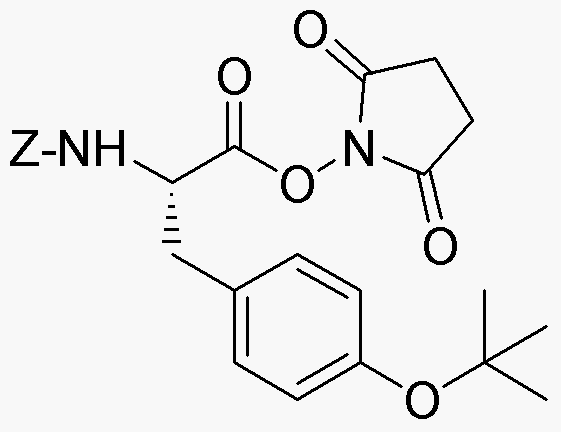Z-O-tert-butyl-L-tyrosine N-hydroxysuccinimide ester is widely utilized in research focused on:
- Peptide Synthesis: This compound serves as a valuable building block in the synthesis of peptides, particularly in solid-phase peptide synthesis, allowing for the efficient incorporation of tyrosine residues.
- Drug Development: It plays a crucial role in the development of pharmaceuticals, especially in creating prodrugs that enhance the bioavailability of therapeutic agents.
- Bioconjugation: The compound is used in bioconjugation techniques, facilitating the attachment of biomolecules to surfaces or other molecules, which is essential in creating targeted drug delivery systems.
- Research in Neuroscience: Due to its structural similarity to neurotransmitters, it is utilized in studies investigating the role of tyrosine in neurotransmission and its potential effects on mood and cognition.
- Diagnostics: This chemical can be employed in the development of diagnostic tools, particularly in assays that require specific binding interactions with proteins or antibodies.
General Information
Properties
Safety and Regulations
Applications
Z-O-tert-butyl-L-tyrosine N-hydroxysuccinimide ester is widely utilized in research focused on:
- Peptide Synthesis: This compound serves as a valuable building block in the synthesis of peptides, particularly in solid-phase peptide synthesis, allowing for the efficient incorporation of tyrosine residues.
- Drug Development: It plays a crucial role in the development of pharmaceuticals, especially in creating prodrugs that enhance the bioavailability of therapeutic agents.
- Bioconjugation: The compound is used in bioconjugation techniques, facilitating the attachment of biomolecules to surfaces or other molecules, which is essential in creating targeted drug delivery systems.
- Research in Neuroscience: Due to its structural similarity to neurotransmitters, it is utilized in studies investigating the role of tyrosine in neurotransmission and its potential effects on mood and cognition.
- Diagnostics: This chemical can be employed in the development of diagnostic tools, particularly in assays that require specific binding interactions with proteins or antibodies.
Documents
Safety Data Sheets (SDS)
The SDS provides comprehensive safety information on handling, storage, and disposal of the product.
Product Specification (PS)
The PS provides a comprehensive breakdown of the product’s properties, including chemical composition, physical state, purity, and storage requirements. It also details acceptable quality ranges and the product's intended applications.
Certificates of Analysis (COA)
Search for Certificates of Analysis (COA) by entering the products Lot Number. Lot and Batch Numbers can be found on a product’s label following the words ‘Lot’ or ‘Batch’.
Numéro de catalogue
Numéro de lot/série
Certificates Of Origin (COO)
This COO confirms the country where the product was manufactured, and also details the materials and components used in it and whether it is derived from natural, synthetic, or other specific sources. This certificate may be required for customs, trade, and regulatory compliance.
Numéro de catalogue
Numéro de lot/série
Safety Data Sheets (SDS)
The SDS provides comprehensive safety information on handling, storage, and disposal of the product.
DownloadProduct Specification (PS)
The PS provides a comprehensive breakdown of the product’s properties, including chemical composition, physical state, purity, and storage requirements. It also details acceptable quality ranges and the product's intended applications.
DownloadCertificates of Analysis (COA)
Search for Certificates of Analysis (COA) by entering the products Lot Number. Lot and Batch Numbers can be found on a product’s label following the words ‘Lot’ or ‘Batch’.
Numéro de catalogue
Numéro de lot/série
Certificates Of Origin (COO)
This COO confirms the country where the product was manufactured, and also details the materials and components used in it and whether it is derived from natural, synthetic, or other specific sources. This certificate may be required for customs, trade, and regulatory compliance.


